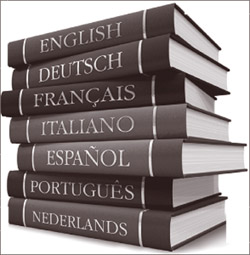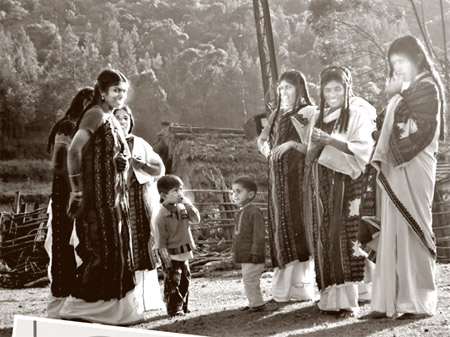|
International Mother Language Day on Tuesday:
Mother tongue - an impetus to education
By Pramod DE SILVA
 How
do we differ from animals? There are a lot of factors, but one factor
nearly always comes on top. We can speak! How
do we differ from animals? There are a lot of factors, but one factor
nearly always comes on top. We can speak!
The power of speech is unique to humans, even though some advanced
mammals do have a rudimentary communications system. And humans speak
nearly 6,700 languages all over the world.
Every human has a native language, also called the mother tongue. The
mother tongue is the language that we learn to recognise and speak from
the very early days. We may learn three or four languages later, but we
are truly at home only when expressing ourselves in the mother tongue.
We are proud of our mother tongue, no matter where in the world we live
in.
For most Sri Lankans, the mother tongue would be either Sinhala or
Tamil.
If you are a native of the US, it could be English or Spanish. Born
in France? Then you would be speaking French. If you are from Japan, you
would be fluent in Japanese. And the list goes on.
Our linguistic diversity is worthy of celebration. This is the aim of
the International Mother Language Day (IMLD), which will be observed on
Tuesday (February 21) for the 13th time around the world. The day was
established in 1999 by UNESCO. The IMLD seeks to promote linguistic and
cultural diversity, as well as multilingualism.
|

Tribal languages face extinction |
The genesis of the IMLD was in former East Pakistan (present day
Bangladesh), where four Bengali language activists were killed while
protesting against the suppression of their native tongue (Bengali) on
February 21, 1952. The Shaheed Minar (martyr's monument) in Dhaka pays
respect to the four protesters. In fact, it was Bangladesh that proposed
the very idea of having a Mother Language Day to the UN.
The IMLD theme for this year is 'Mother tongue instruction and
inclusive education'. An international photography contest is also being
arranged as a part of the activities of International Mother Language
Day 2012. The Linguapax Institute, in Barcelona, Spain, which aspires to
protect and encourage linguistic assortment worldwide, awards the
Linguapax Prize on International Mother Language Day every year. The
award is for those who have made exceptional work in linguistic
diversity or multilingual learning.
Right to education
The UNESCO wants Member States to highlight the importance of the
mother tongue from the angle of the right to education and encourage
each Member State to promote instruction and education in their mother
tongue. It has been proven that children learn best when they are
instructed in their mother language during their first years at school,
according to UNESCO. This is an apt theme that tallies with UNESCO’s
goal of universal education for children at least until 14-15 years.
Providing education in the mother tongue widens access, enabling more
children to attend school.
 That
is how languages are preserved and perpetuated. With each generation
that learns a language, its survival is assured. This process is called
‘intergenerational transmission’. However, thousands of languages across
the globe face the problem of having fewer speakers every passing year.
Yes, as some tribes face extinction, so do their languages. That
is how languages are preserved and perpetuated. With each generation
that learns a language, its survival is assured. This process is called
‘intergenerational transmission’. However, thousands of languages across
the globe face the problem of having fewer speakers every passing year.
Yes, as some tribes face extinction, so do their languages.
According to UNSECO “half of the 6,700 languages spoken today are in
danger of disappearing before the century ends, a process that can be
slowed only if urgent action is taken by governments and speaker
communities.” The death of a language is the loss of a unique cultural
trait – it is a very sad event indeed.
Today, linguists are working with speakers of endangered native
languages to preserve them for posterity through the use of modern
technology.
However, this is compounded by the fact that many languages do not
have a written script. Some ancient civilisations can still ‘speak’ to
us because they left written inscriptions, but the future looks bleak
for languages that are purely oral.
Once the last speaker dies, his or her language usually dies. There
are at least 10 languages which are each spoken by less than 10 people.
The loss of a language is a black mark on the collective human
conscience. A language represents a particular culture, a way of life
and the very soul of a particular community of people.
UNESCO has taken a commendable step by publishing an 'Atlas of the
World’s Languages' which lists languages in danger. It is intended to
raise awareness about language endangerment and the need to safeguard
the world’s linguistic diversity among policy-makers, speaker
communities and the public, and to be a tool to monitor the status of
endangered languages and the trends in linguistic diversity at the
global level.
Endangered languages
The latest edition of the Atlas lists about 2,500 languages (among
which 230 languages have been extinct since 1950), approaching the
generally-accepted estimate of some 3,000 endangered languages
worldwide. For each language, the Atlas provides its name, degree of
endangerment and the country or countries where it is spoken.
On the other hand, a few dominant languages are spoken by the vast
majority of people. Chinese (Mandarin), Spanish, English, French, Hindi,
Urdu, Arabic, Bengali, Portuguese, Russian and Japanese are among the
top languages in terms of the number of native speakers. Most of these
languages are also popular as second and foreign languages. English is
fast becoming ‘the’ language of the world – it is already the top
language for international diplomacy, trade and business, literature,
science and the World Wide Web. It is also the language that most people
learn as a second language.
Learning another language is one’s passport to another world. When
you learn a new language, you enter a world that was previously out of
bounds.
Today, millions of people around the world are learning another
language or two. Language classes and self-study courses are a big
business. You may never reach native fluency, but it is generally
accepted that one can ‘get by’ in a foreign language with around 3,000
words and the knowledge to combine them into simple sentences.
Not knowing each other’s language can lead to a lot of problems in
multi-ethnic, multi-cultural societies. We have experienced this problem
in our island. Sri Lanka would have been a much more peaceful country if
all Sinhalese knew Tamil and vice versa. The Government has declared
2012 as the Year of Trilingual Sri Lanka and launched an ambitious
program to make every Sri Lankan fluent in the three main languages
spoken in the country – Sinhala, Tamil and English under a 10-year plan.
This is a laudable initiative that will augment the country’s
reconciliation process.
Thanks to migration, languages such as Sinhala and Tamil are now
spoken in many cities around the world. Go to a city such as New York,
and you can hear hundreds of languages being spoken in the streets,
restaurants and taxis.
Languages enrich cultures around the world.
No language can exist in isolation in today’s globalised world.
Languages evolve over time and absorb words from other languages.
Sinhala is a good example – it has a large number of words derived from
Portuguese, Dutch and English - the languages of the former colonial
powers.
New words
Languages get new words all the time – dictionary compilers have a
tough time keeping track of them all. Just a few years ago, if someone
told you that he stored documents ‘in the cloud’ you would have
considered sending him to the psychiatric ward. Now everyone knows what
it means. This is just one example of how new words and terms form and
how old words acquire new meanings.
If you have a very good knowledge of English, you could be
unwittingly using around 5,000 French and Latin words. And one can find
strikingly similar words in many languages. One example is the number
‘Three’ in English, which translates to ‘thuna’ in Sinhala, treis
(Greek), tres (Portuguese), trios (French) and tri (Russian).
This is also compelling evidence that many languages have been
derived from a common source. Sinhala, for example, is classified in the
broader sense as an Indo-European language along with English, Spanish,
Hindi, Portuguese, Bengali, Russian, French, Italian, Marathi, Punjabi
and Urdu. This makes learning another language similar to your own
mother tongue somewhat easier. A language that may seem totally strange
at first may appear familiar once you learn a few words.
Languages that we ‘inherit’ or learn in this manner can bridge
cultural and ethnic divides. Go anywhere in the world and just speak a
word or two in the mother tongue of a native – you will instantly know
the difference it makes.
Languages bring communities – and the world together. In celebrating
languages, we are celebrating the very essence of humanity. The IMLD is
an ideal opportunity to reflect on the importance of our native
languages and the efforts being made to protect all languages for
posterity. |

